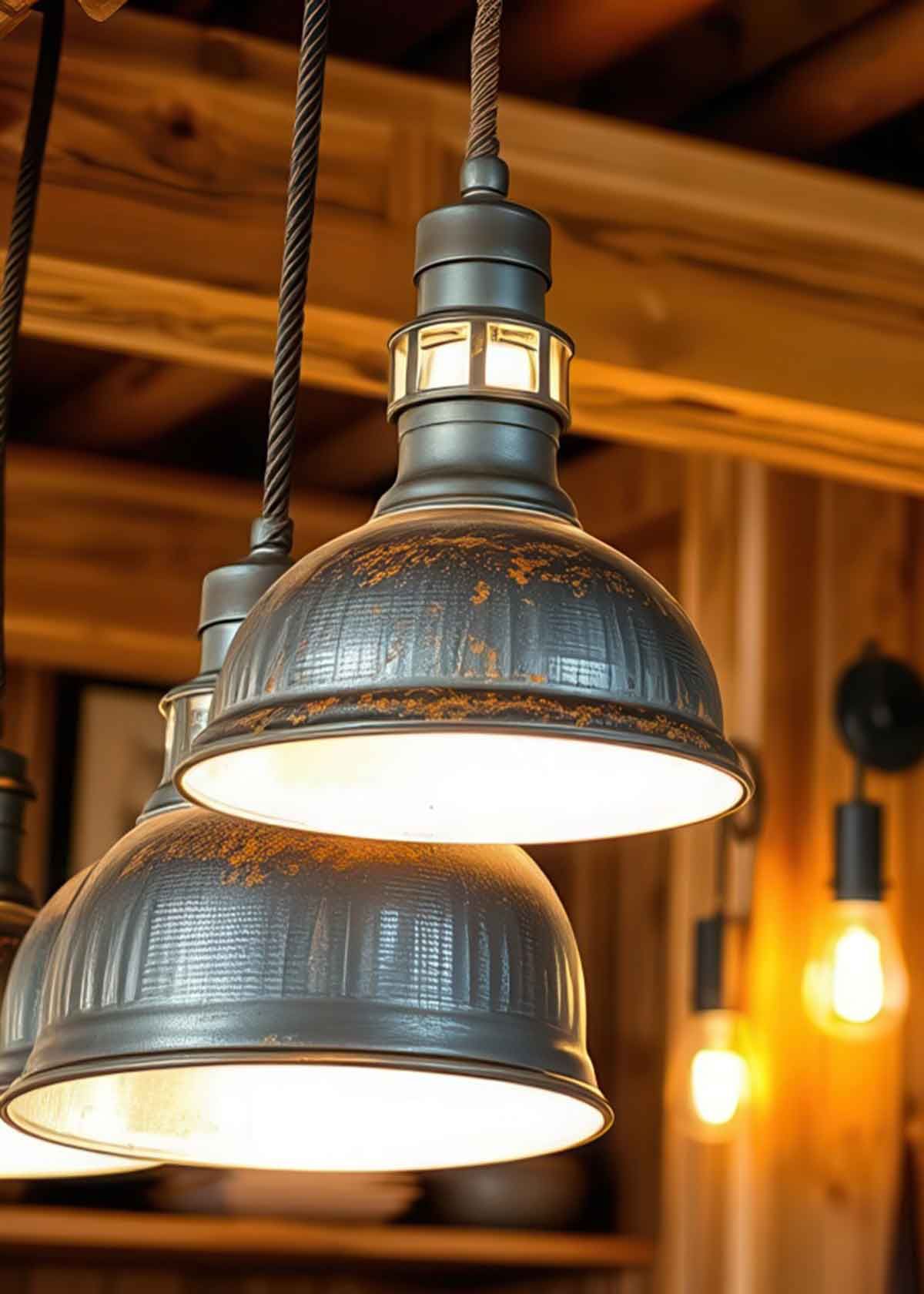The Role of Textiles in Farmhouse Interiors
Textiles For Farmhouse or Rustic Interiors
Today I’m excited to talk about farmhouse design textiles . I’ve spent years making homes in Australia cozy, mostly because I simply could not afford the furnishings and lighting I wanted. I discovered though that textiles are key to that warm, inviting feel we all love.
Farmhouse style is here to stay, blending with today’s tastes. Textiles are more popular than ever, with 70% of homes using calming colours like beige and cream. It’s all about making a space that feels like home.
Mixing fabrics is crucial for that farmhouse look, I’ve found. About 40% of designers, enjoy mixing prints for a unique look. It’s like solving a puzzle, where each piece adds charm.
Durability is also important when choosing textiles. In fact, 65% of designers focus on this. We want our homes to look great and last through daily life. That’s why linen and cotton canvas are favorites – they’re beautiful and durable.
Textiles are your secret weapon for any room makeover. They’re the heart of farmhouse design, adding warmth, texture, and personality. Let’s explore how to use textiles to make your home a farmhouse haven!
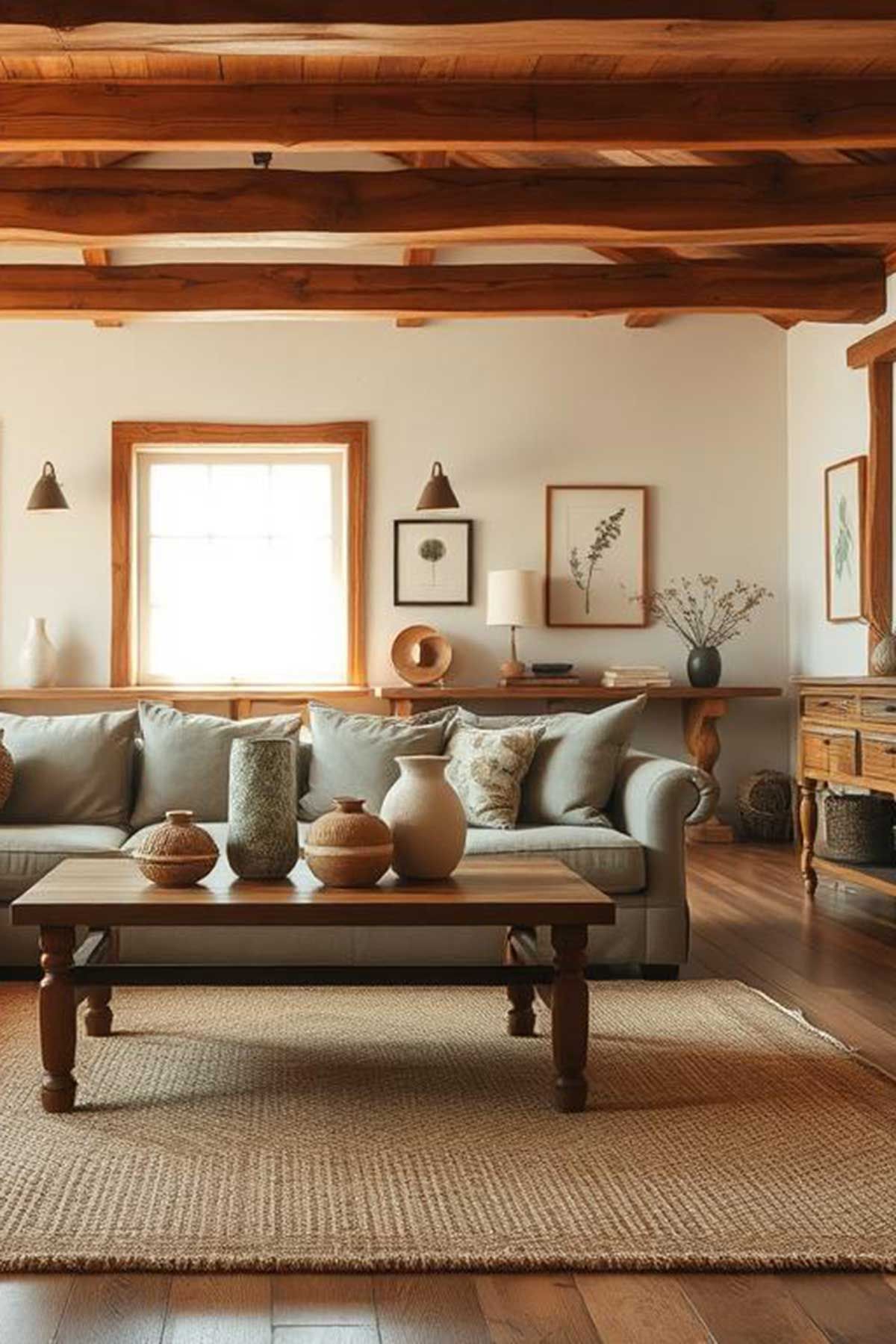
A farmhouse styled living room with multiple textiles creating a cosy feel
Understanding Traditional Farmhouse Textile Elements
Farmhouse design textiles have a rich history. They come from rural life and tell stories of family traditions. These fabrics have shaped the cozy farmhouse style we love today.
Historical Significance of Farm Textiles
Farm textiles were once just for practical use. Burlap sacks stored grain, and cotton sheets kept people warm. Now, these simple materials are treasured for their design value.
Vintage quilts and worn fabric pieces add character to modern homes. They bring a sense of history and warmth.
Evolution of Farmhouse Fabric Choices
Today, farmhouse fabrics mix old and new. Linen, chosen in 50% of projects, is durable and natural. Cotton canvas, used in 30% of upholstery, brings earthy tones and strength.
Burlap, adds a rustic charm and shows how simple materials can become stylish.
Core Characteristics of Farmhouse Textiles
Farmhouse design textiles focus on comfort and simplicity. Neutral tones like beiges and creams are used in 70% of upholstery. Soft grays add sophistication in 60% of interiors.
Patterns like stripes and checks bring a nostalgic feel. Durability is key, with 80% of designers choosing fabrics that last for farmhouse furniture.
| Fabric Type | Usage Percentage | Key Characteristics |
|---|---|---|
| Linen | 50% | Durable, natural texture |
| Cotton Canvas | 30% | Earthy tones, strong |
| Burlap | 10% | Rustic authenticity |
| Herringbone Tweed | 15% | Subtle texture, warm |
Essential Fabrics in Farmhouse Design
Farmhouse furnishings use specific textiles to add warmth and character. Let’s look at the key fabrics that make this style popular.
Grain Sacks and Their Modern Applications
Grain sacks are a big part of farmhouse design. They mix history with style. You can find them in pillow covers, table runners, and upholstery.
Their neutral tones and subtle stripes are great for adding texture. They do this without making a space feel too busy.
Ticking Stripes: A Timeless Choice
Ticking stripes are often overlooked but are very important in farmhouse design. They have a distinctive narrow stripe pattern, usually in blue or black on white.
I like using ticking for curtains, bedding, and throw pillows. It adds a classic farmhouse look without being too much.
Linen’s Role in Farmhouse Aesthetics
Linen is a key fabric in farmhouse design. It’s great for curtains, tablecloths, and bedding. Linen’s natural, slightly wrinkled texture brings a relaxed feel to any room.
Mixing different weights of linen can add depth and interest. It makes a space feel more inviting.
| Fabric | Common Uses | Popularity in Farmhouse Design |
|---|---|---|
| Grain Sacks | Pillow covers, Table runners | 65% |
| Ticking Stripes | Curtains, Bedding | 70% |
| Linen | Curtains, Tablecloths, Bedding | 80% |
These fabrics are the heart of farmhouse design. Using them in your home can make it cozy and welcoming. It will truly reflect the farmhouse aesthetic.
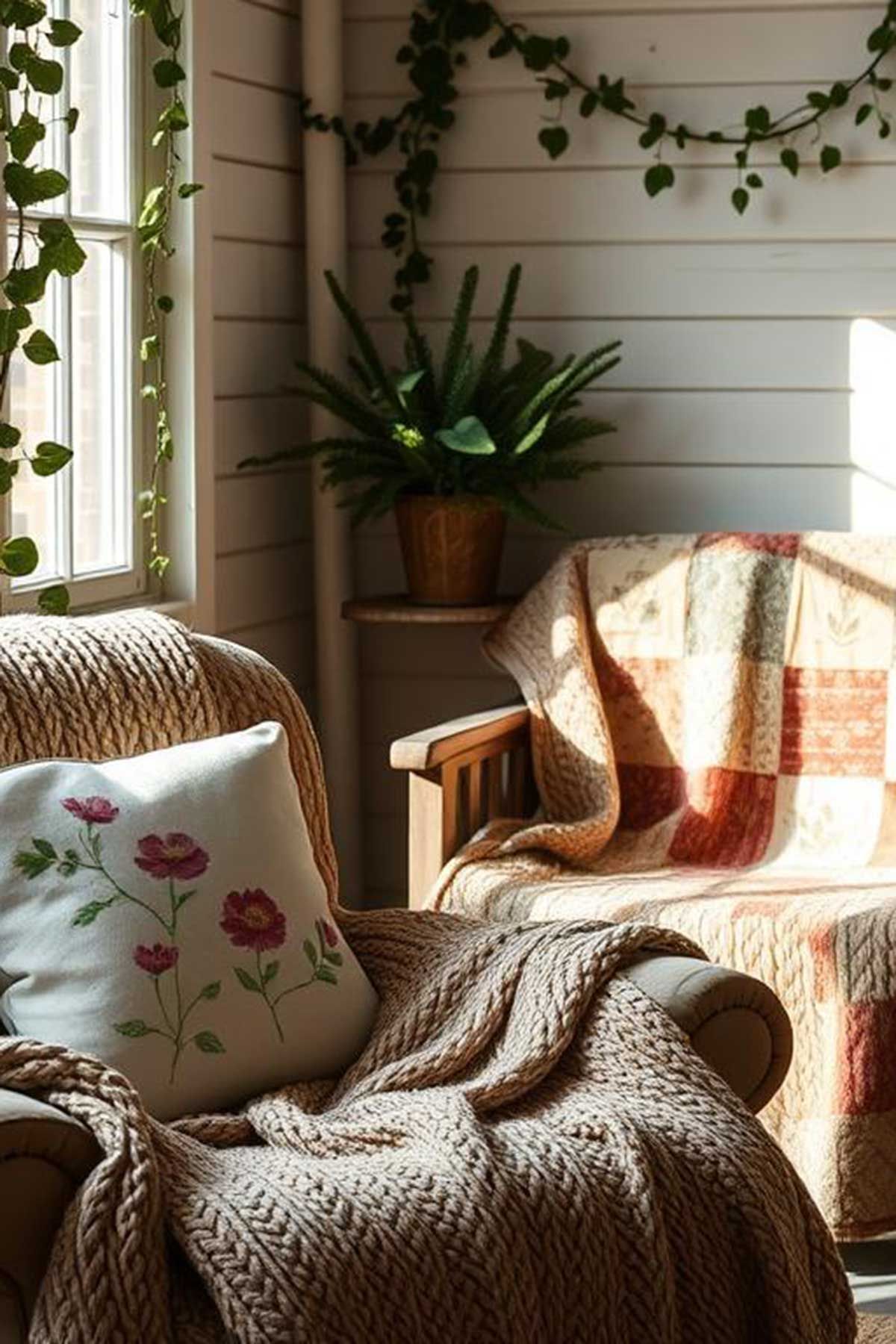
Soft knitted rugs and printed cushions create a cozy farmhouse feel in this sitting area
Colour Palettes and Patterns for Farmhouse Textiles
Farmhouse design textiles aim to create a cozy, welcoming space. The color scheme often focuses on neutral tones, but it’s not dull. Adding vibrant colors can make a room lively.
For a true farmhouse look, start with soft whites, warm beiges, and light grays. These colors enhance light, making rooms feel open and bright. For farmhouse interiors, I prefer adding muted blues, greens, and earthy tones as highlights.
When it comes to patterns, mixing them is an art. But it’s a skill worth mastering. I’ve found success with combining plaids, ginghams, and florals. The secret is to use a consistent color scheme to tie everything together. Here’s a quick guide to some popular farmhouse patterns:
- Buffalo check: Bold and classic
- Ticking stripe: Subtle and versatile
- Floral: Adds a soft, feminine touch
- Herringbone: Provides texture and interest
Farmhouse style emphasizes comfort and practicality. It’s okay to mix different textures. Think fluffy rugs, soft linens, and distressed wood for that farmhouse vibe.
| Color Palette | Mood | Ideal Use |
|---|---|---|
| Sage Serenity | Calming | Bedrooms, Living Rooms |
| Coastal Farmhouse | Refreshing | Kitchens, Bathrooms |
| Vintage Meadow | Romantic | Dining Rooms, Guest Rooms |
| Earthy Tones | Grounding | Home Offices, Studies |
Textiles in Farmhouse Design: Key Implementation Strategies
Farmhouse furnishings are not complete without the right textiles. They help create a cozy, lived-in feel. Let’s look at some key strategies I’ve learned.
Window Treatments and Drapery
Window treatments are crucial for a farmhouse look. I prefer linen or cotton curtains in neutral shades. They add softness and let natural light in.
For a budget-friendly option, try DIY drop cloth curtains. They add a rustic touch!
Upholstery Considerations
Comfort is key in upholstery. Choose durable fabrics like cotton or linen blends for sofas and armchairs. Patterns like plaids or stripes can add interest without overwhelming the space.
Decorative Accents and Layers
Layering textiles is where the magic happens. Mix textures and patterns to create depth. Try combining a chunky knit throw with smooth linen pillows.
Vintage quilts are great for wall hangings or sofa covers. Remember, imperfection is part of the charm in farmhouse design.
| Textile | Best Use | Typical Colors |
|---|---|---|
| Linen | Curtains, Upholstery | Natural, White, Beige |
| Cotton | Bedding, Throws | White, Cream, Pastels |
| Wool | Rugs, Blankets | Gray, Brown, Natural |
By thoughtfully incorporating these textiles, you’ll create a stylish and inviting space. The key is to keep it relaxed and authentic – just like life on the farm!
Mixing and Matching Farmhouse Fabrics
Farmhouse design textiles are perfect for creating a cozy, inviting space. By learning to mix and match fabrics, you can make a space that’s uniquely yours. It will show off your style while keeping the farmhouse feel.
Pattern Coordination Techniques
Pattern coordination is essential in farmhouse design. Stripes, checks, and florals are favorites. Stripes are used in 55% of projects for their timeless look. Mixing prints can give your space a unique, eclectic farmhouse vibe.
Try combining checks, stripes, and even farm animal motifs. This adds visual interest to your furniture.
Texture Combinations
Texture is key in farmhouse fabrics. Linen is the top pick, used in 50% of projects for its durability and comfort. Cotton canvas is also popular, chosen in 35% of designs for its natural feel.
Don’t be afraid to mix different textures. Try burlap, herringbone tweed, and soft cotton for a rich, layered look.
Seasonal Textile Transitions
Changing your fabrics seasonally keeps your space fresh all year. In cooler months, choose heavier fabrics like wool and tweed. For spring and summer, go for lighter materials like linen and cotton.
This way, you can keep your decor up-to-date with the seasons. Yet, you still keep that classic farmhouse charm.
| Fabric | Usage in Farmhouse Designs | Characteristics |
|---|---|---|
| Linen | 50% | Durable, comfortable, softens with use |
| Cotton Canvas | 35% | Durable, natural texture |
| Burlap | 20% | Rustic appeal, strong weave |
| Herringbone Tweed | 15% | Warm, subtle texture |
Natural and Sustainable Textile Choices
Farmhouse design is now embracing eco-friendly options. I’m excited to share some great sustainable choices for textiles. As we learn more about our environmental impact, it’s key to think about the materials we use at home.
Organic cotton is a big deal in farmhouse furnishings . It’s grown without harmful pesticides, helping our planet and biodiversity. Organic cotton bedding and curtains bring a soft, natural feel to any farmhouse room.
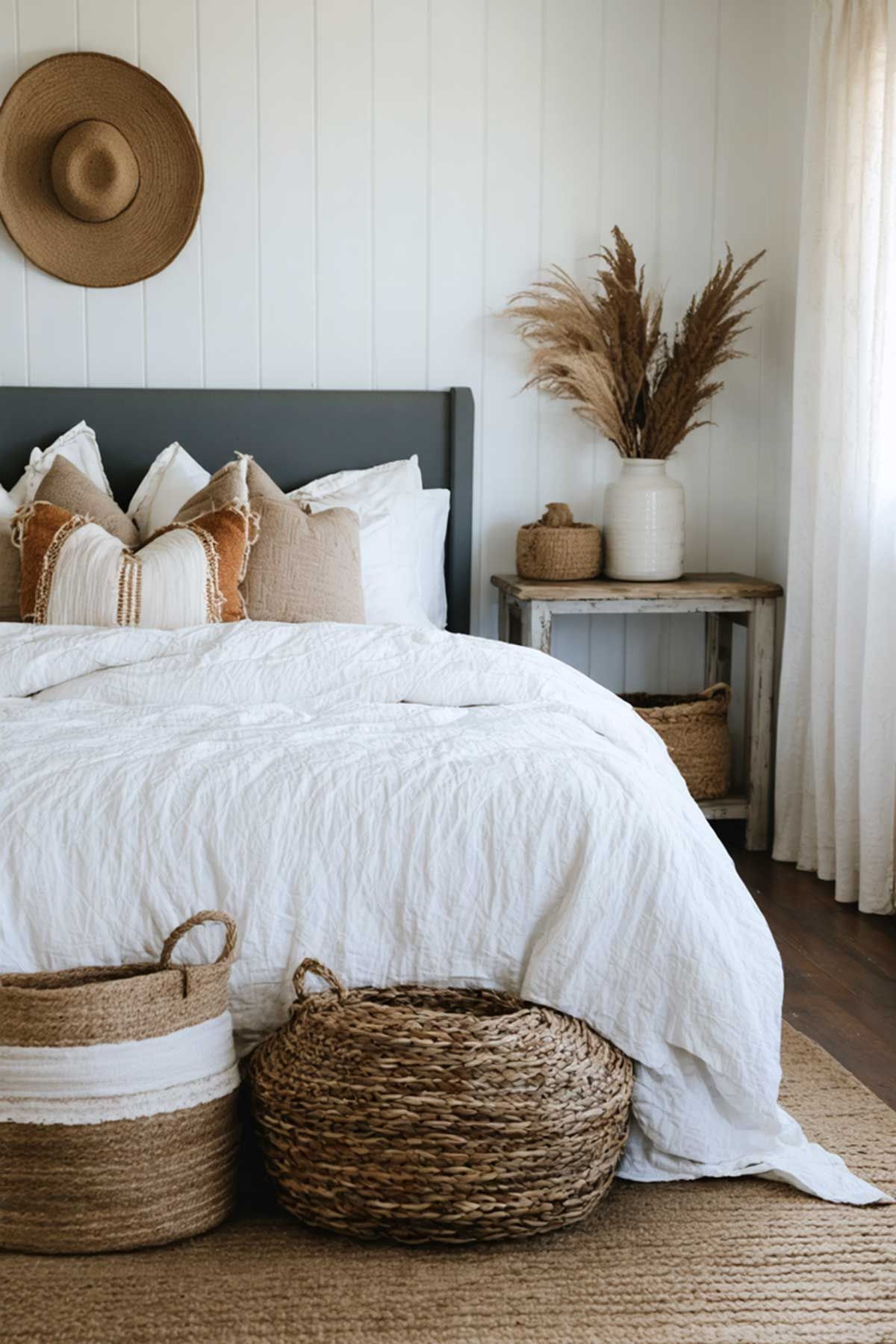
You don’t have to use florals and patterns either. This white and naturally toned bedroom uses different textures to create a farmhouse vibe.
Hemp is another eco-friendly star. It needs little water and no synthetic fertilizers. Hemp throw pillows and table runners add texture and warmth to our homes.
Wool and linen are timeless favorites in farmhouse design. Wool is biodegradable and renewable. Linen uses fewer resources than many fabrics. Both are great for cozy, inviting farmhouse interiors.
| Sustainable Textile | Environmental Benefit | Farmhouse Application |
|---|---|---|
| Organic Cotton | 70% reduction in global warming potential | Bedding, curtains |
| Hemp | Minimal water usage, no synthetic fertilizers | Throw pillows, table runners |
| Wool | Biodegradable and renewable | Blankets, area rugs |
| Linen | Low resource consumption in production | Upholstery, napkins |
Choosing these sustainable options helps us create beautiful farmhouse interiors. It also helps our planet. It’s a win-win for style and sustainability!
Vintage and Antique Textiles in Farmhouse Decor
Farmhouse design textiles add charm and history to your home. Vintage pieces have a unique character that new ones can’t match. Let’s see how to bring these treasures into your space.
Incorporating Heritage Quilts
Quilts share stories through their patterns and stitches. I enjoy draping them over chairs or using them as wall art. For a budget-friendly option, look for smaller quilts or coverlets at flea markets.
Collecting Vintage Linens
Vintage linens add softness to farmhouse interiors. I’ve found beautiful pieces on Etsy and at antique stores. Tablecloths, napkins, and tea towels in natural fibers like linen or cotton work best.
Look for delicate embroidery or classic patterns to enhance your farmhouse look.
Care and Preservation Tips
Caring for vintage fabrics ensures they last. I always hand wash delicate pieces in cool water with mild soap. For storage, wrap items in acid-free tissue paper.
Display them away from direct sunlight to prevent fading. With proper care, these textiles will beautify your home for years.
| Textile Type | Best Use | Care Method |
|---|---|---|
| Quilts | Bedding, Wall Art | Gentle Machine Wash |
| Linen Tablecloths | Dining, Curtains | Hand Wash |
| Embroidered Pillows | Accent Decor | Spot Clean |
Integrating vintage textiles into your farmhouse decor creates a unique, lived-in feel. These fabrics for farmhouse interiors tell stories and add layers of comfort to your space. Start your collection today and watch your home transform with each special find.
Modern Interpretations of Farmhouse Textiles
The modern farmhouse style has brought new life to old textiles. It mixes rustic charm with modern flair, creating a cozy yet elegant look. Today, farmhouse decor combines old and new, showing a love for authenticity and comfort.
In 2024, designers are using bold colors to add personality to homes. Colors like emerald green, navy blue, and terracotta are becoming common. They’re used in throw pillows, blankets, and furniture, adding depth to the usual neutral colors.
Textiles in farmhouse design are getting more detailed and textured. Geometric prints and modern toile designs are becoming popular. These patterns add interest while keeping the style warm and welcoming.
| Traditional Farmhouse | Modern Farmhouse |
|---|---|
| Muted colors | Bold accent hues |
| Simple patterns | Geometric and modern toile prints |
| Cotton and wool | Linen, faux fur, and sustainable fabrics |
| Vintage accessories | Mix of old and new decor |
Natural and sustainable materials are key in modern farmhouse textiles. Linen, jute, and organic cotton are favorites. They match the farmhouse look and appeal to those who care about the environment.
Textile Placement and Room-Specific Applications
Farmhouse design textiles are key to making your home cozy and welcoming. Let’s see how to use them in various rooms.
Living Room Textile Strategies
In the living room, farmhouse furnishings come alive with the right textiles. Mix patterns and solids in throw pillows for a balanced look. Use throw blankets for texture, keeping colors the same.
For art, choose blues, greens, whites, and blacks. They add depth without overwhelming the room.

Practical throws and cushions add texture to this farmhouse styled living area
Bedroom Textile Solutions
Make your bedroom a cozy retreat with soft fabrics. Layer quilts, linens, and throw pillows for comfort. Choose fabrics that also improve sound quality, making it quieter.
Kitchen and Dining Room Applications
Bring farmhouse textiles to your kitchen and dining with tablecloths, napkins, and cushions. Pick durable, easy-to-clean fabrics for these busy areas. Use lighter weaves in summer and thicker ones in winter.
Farmhouse design textiles greatly affect your home’s feel. By layering textures and picking the right fabrics for each room, you’ll enjoy a rich, inviting space.
Durability and Maintenance of Farmhouse Fabrics
Farmhouse style is more than just looks. It’s about making a space that’s both beautiful and functional. Choosing durable fabrics is crucial for this style. Here are some tips for picking and caring for fabrics that last and stay charming.
Farmhouse fabrics often use natural fibers like cotton and linen. These materials are durable and let air in. In fact, demand for sustainable home fabrics has grown by 35% in the U.S. in five years.
For upholstery, go for linen or cotton blends. They look good and can handle a lot of use. For busy spots, leather is a great choice. About 30% of homeowners pick leather for basement furniture because it’s both durable and stylish.
| Fabric Type | Durability | Maintenance |
|---|---|---|
| Linen | High | Regular vacuuming, spot cleaning |
| Cotton | Medium | Machine washable, spot cleaning |
| Leather | Very High | Wipe clean, condition periodically |
| Denim | High | Machine washable, spot cleaning |
To keep your farmhouse textiles in top shape, regular cleaning is essential. Vacuum upholstered furniture every week and clean spills right away. Wash fabrics that can be machine washed, and follow the care label. Leather furniture needs to be wiped clean and conditioned to avoid cracking.
The charm of farmhouse style comes from its lived-in feel. Don’t worry about small imperfections – they add to the space’s authenticity. With the right care, your farmhouse fabrics will stay beautiful for many years.
Shopping Guide for Farmhouse Textiles
Ready to make your home look like a farmhouse? Let’s explore where to find the best textiles for your space.
Quality Assessment Tips
Quality is crucial when picking farmhouse textiles. Look for materials like linen and cotton. They last long and get even more beautiful with age.
Check the weave for tightness and evenness. Vintage items might show wear, but that’s part of their charm.
Where to Source Materials
Finding real farmhouse textiles is an exciting journey. Here are some great places:
- Flea markets and antique stores for vintage quilts and linens
- Online marketplaces like eBay and Etsy for grain sacks and mangle cloths
- Local fabric stores for quality linen and ticking fabric
- Specialty home decor shops for curated farmhouse furnishings like Cargo Lane who has some great Jute and Fibre Rugs. They are based in Bellingen but ship all over Australia.
Budget-Friendly Options
Creating a farmhouse look doesn’t have to cost a lot. Here are some affordable ideas:
- DIY grain sack pillows using plain canvas and fabric paint
- Repurpose old tablecloths into curtains or chair covers
- Shop end-of-season sales for discounted farmhouse furnishings
- Mix high-end pieces with budget finds for a curated look
The beauty of farmhouse design is mixing old and new. Blend vintage textiles with modern pieces for a space that’s uniquely yours.
Conclusion
Textiles in farmhouse design are key to creating a cozy, welcoming feel. Natural materials and vintage touches make farmhouse style popular in Australia and worldwide. It’s all about warmth and charm.
Farmhouse textiles are versatile and add depth to a room. Mixing textures and colors creates a lively atmosphere. Think soft linens, rough-hewn textures, and calming colors like white and gray.
Modern farmhouse design combines old and new beautifully. It’s perfect for any home, whether in the city or countryside. Using sustainable materials like reclaimed wood adds a thoughtful touch to your decor.
When decorating with farmhouse textiles, think about what feels like home. It’s about comfort, character, and that rustic charm we all love. Happy decorating!
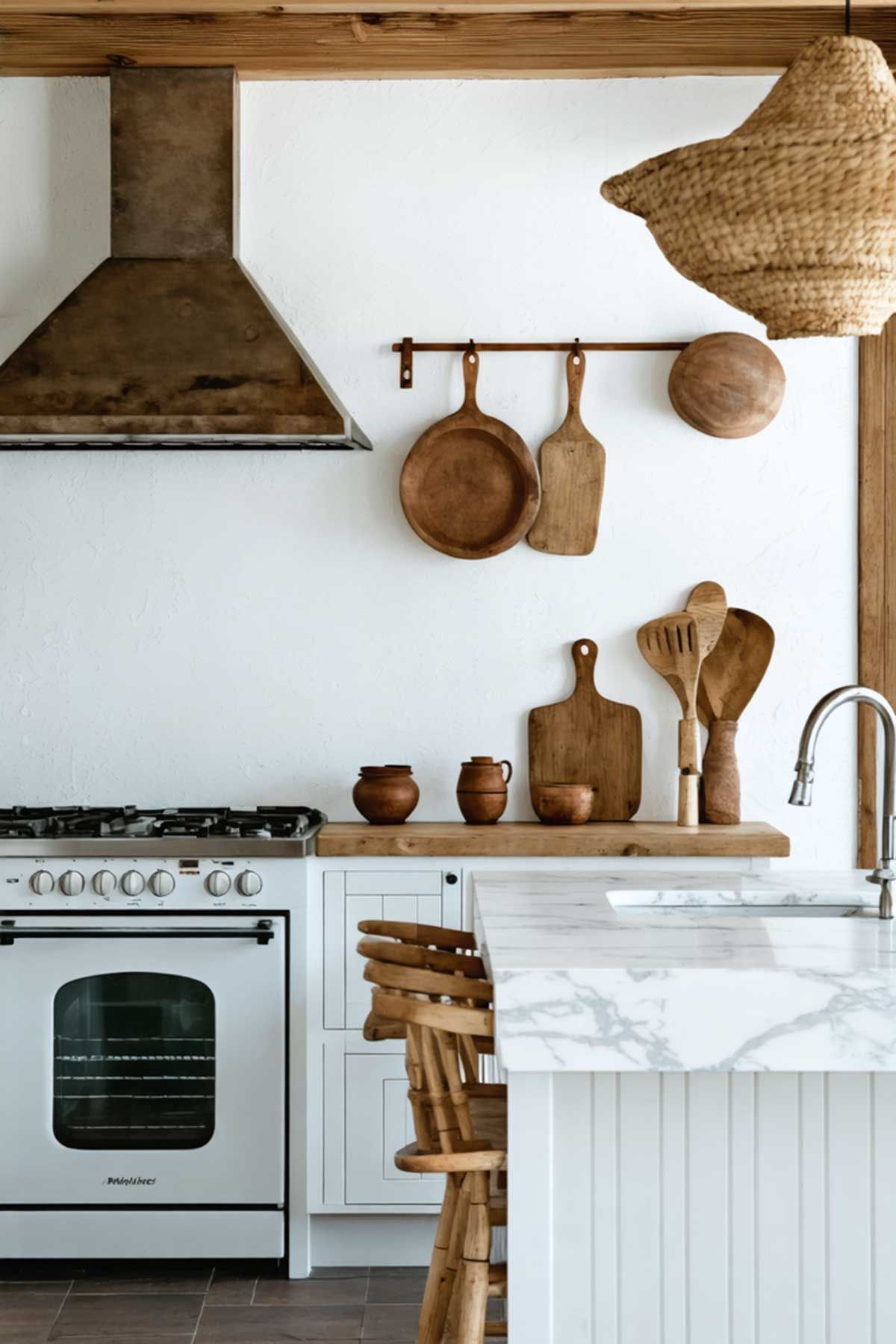
Don’t forget that “Farmhouse” doesn’t have to mean cluttered. This stark white kitchen feels very rustic farmhouse simply because of the materials used and the timber accessories on display.
FAQ
What are the essential fabrics in farmhouse design?
Grain sacks, ticking stripes, and linen are key in farmhouse design. Grain sacks bring a rustic charm. Ticking stripes offer a classic look. Linen adds a natural feel.
How can I incorporate vintage textiles into my farmhouse decor?
Use heritage quilts as wall hangings or bed covers. Collect vintage linens for table settings or decor. Use antique fabric for pillow covers or framed art. Always care for these pieces well.
What color palettes work best for farmhouse textiles?
Farmhouse style often uses neutral tones like whites, beiges, and grays. You can also use muted colors and earth tones. Adding pops of color through textiles adds interest while keeping the farmhouse look.
How do I mix and match farmhouse fabrics effectively?
Start with neutral colors and add patterns in different scales. Mix textures like burlap with linen for contrast. Keep a cohesive color scheme and balance bold patterns with subtle ones.
What are some sustainable textile choices for farmhouse interiors?
Choose organic cotton, hemp, and recycled materials for farmhouse interiors. These options are eco-friendly and align with the farmhouse ethos of natural living.
How can I use textiles to create a cozy farmhouse bedroom?
Layer quilts, knit blankets, and linen sheets for texture. Use soft, neutral curtains and add decorative pillows. Consider a farmhouse-inspired upholstered headboard for comfort and style.
What are some budget-friendly options for farmhouse textiles?
DIY projects like drop cloth curtains or pillow covers are affordable. Shop at thrift stores or flea markets for vintage pieces. Look for linen-blend fabrics for a lower cost. Upcycle old fabrics to create new decor items.
How do I care for and maintain farmhouse fabrics?
Follow the care instructions for each fabric. Natural fibers like linen and cotton can be machine washed in cold water and air-dried. For vintage or delicate pieces, hand washing or dry cleaning may be needed. Regular vacuuming and spot cleaning maintain upholstered items.
What are some modern interpretations of farmhouse textiles?
Modern farmhouse textiles include bold geometric prints and updated toile designs. Reimagined ticking stripes in new color combinations blend traditional elements with current trends.
Where can I source quality farmhouse textiles?
Find quality farmhouse textiles at specialty home decor stores, online marketplaces like Etsy, fabric stores, and antique shops. Some brands offer farmhouse-inspired collections.
More Farmhouse and Rustic Articles You Might Like

About The Author
I'm Channing and I am the driving force behind Platypus and Pine. I've had over 30 years of experience in designing, renovating and customising Australian homes.
I've used everything from aluminium to velvet as decor choices and love a wide variety of styles and themes.
My absolute favourite is Mid Century Modern and I was fortunate enough to spend 2 weeks in Palm Springs for Modernism week just last year.


